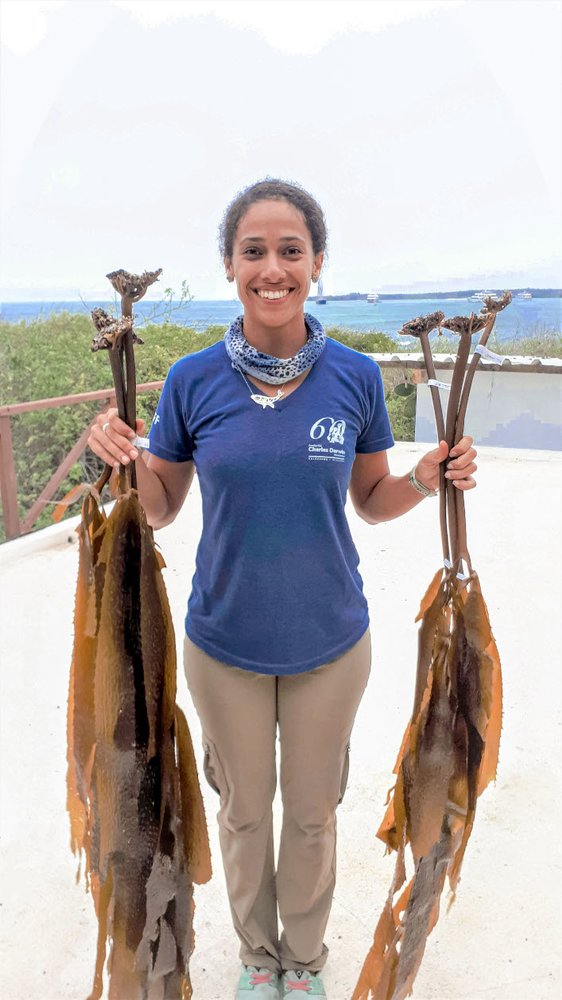The Deep Ocean exploration and conservation program, led by scientists from the Charles Darwin Foundation (CDF), in collaboration with the Galapagos National Park Directorate and a multidisciplinary team of international researchers, found an extensive kelp forest covering the summit of an underwater mountain in the south of the archipelago. This discovery could be a new algae record for the region and even for science.
Kelps are large brown macroalgae that can form dense year-round canopies known as kelp forests. Similar to coral reefs and mangroves, these forests are very important for the maintenance of marine biodiversity, as they provide protection and food for many species.
As kelps are cold water species, most kelp forests are exclusively found in temperate and polar coastal regions and usually at shallow depths because of their permanent need for light. However, the kelp forest uncovered in the Galapagos Marine Reserve is situated in a tropical region and at more than 50 meters depth.

Galapagos was the first place in the world where, in 1934, a species of tropical kelp, called Eisenia galapagensis, was found. This endemic species until recently was the largest seaweed recorded in the archipelago. However, very little is known about its biology or ecology, as it has been scarcely observed since the 1980s and was declared "endangered" by the International Union for Conservation of Nature (IUCN).
"This is the first time that such an extensive and dense kelp forest has been registered in this part of the Galapagos and at such depths. What we found looks very different from the Eisenia galapagensis kelp species already known in this area and is almost twice the size, so there is a possibility that we are looking at a different and potentially new species for the region," said Salomé Buglass, CDF senior scientist and lead researcher.
As standard scuba diving is restricted to depths of 40 meters, CDF’s research teams rely on new technologies such as remotely operated vehicles (ROVs), to explore, document and characterize deep-sea ecosystems such as these kelp forests. By installing a mechanical claw to the ROV, researchers were able to collect specimens of this newly registered kelp in 2018, which is essential to determine its taxonomy and is still under study.
"Despite their enormous importance as ecosystem engineers and as support for the fascinating marine life of the islands Galapagos, the Galapagos macroalgae are the ‘great forgotten’ of the marine ecosystems of the archipelago," notes Dr. Maria Altamirano, researcher at the University of Malaga and a member of the research team and collaborator in this project. "This discovery highlights the importance of ecosystem services offered by this group of organisms, as habitat for other species and in the process of carbon sequestration within deep-sea areas."
"Knowing that there are entire marine forests teeming with life that we were unaware of at just 50m depth, serves as a reminder of how little we know about deep-sea biodiversity, and how much remains to be explored, discovered, learned about and protected," added Salomé Buglass, CDF senior scientist and lead researcher.
The scientists of this multidisciplinary research bring to light the ecological characteristics of this new ecosystem and description of this curious kelp species in a recent scientific manuscript published in the journal Marine Biology on 23rd of November, 2022. Download here.
About the research team
Salome Buglass, CDF researcher and Ph.D. candidate at the University of British Columbia, leads the mesophotic kelp forest study. Collaborating scientists include Dr. Maria Altamirano of the University of Malaga; Hiroshi Kawaii of Kobe University; Dr. Takeaki Hanyuda of Kitasato University; Dr. Julio de la Rosa of Granada University; Dr. Jorge Rafael Bermudez of Escuela Superior Politécnica del Litoral; Dr. Euan Harvey of Curtin University; Dr. Inti Keith of CDF; and Simon Donner of the University of British Columbia.
About the Seamounts / Deep-sea exploration program
The Deep-sea and Seamounts Research project was established following three multi-institutional oceanographic expeditions that took place between 2015 and 2016. These expeditions used ROVs and manned submersibles that made it possible to collect data from seamounts and other ecosystems never before explored at depths of 200m to 3,200m. With the support of the Galapagos National Park Directorate (GNPD) and various international research institutes, CDF is leading the first comprehensive characterization of Galapagos’ deep-sea biodiversity and habitats of these as yet unexplored deep-sea ecosystems.
About the Charles Darwin Foundation and its Research Station
Since 1959, the Charles Darwin Foundation has worked in close partnership with the Galapagos National Park Directorate to protect the Islands’ natural resources and share scientific results for the conservation of this living laboratory. More than one hundred scientists, educators, researchers, support personnel and volunteers from all over the world have participated in this effort. Currently, more than 75% of the staff are Ecuadorian citizens. The Charles Darwin Foundation is committed to the professional development of permanent Galapagos residents as future scientists, for the well-being of the islands and the nation in general.





